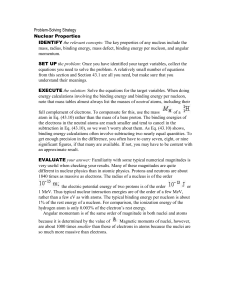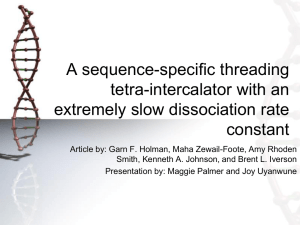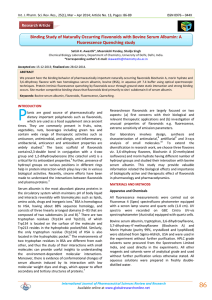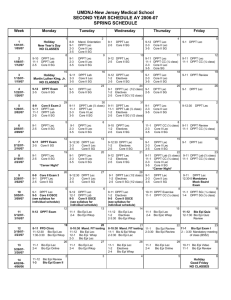Thesis Abstract - Professor H. Hadadzadeh
advertisement
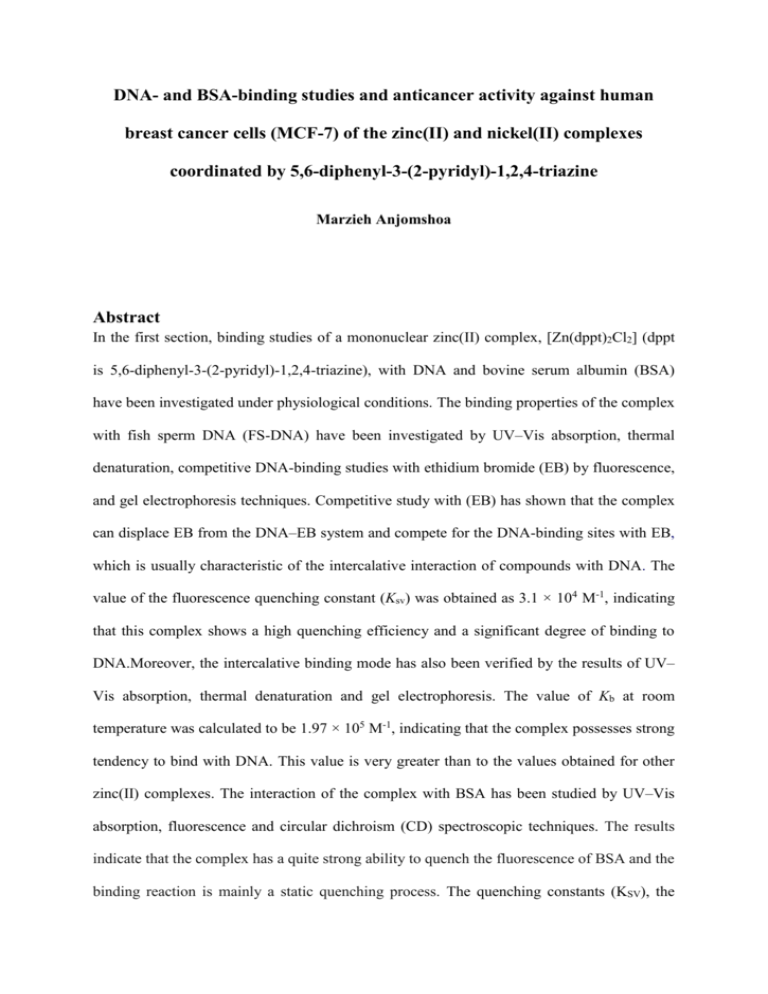
DNA- and BSA-binding studies and anticancer activity against human breast cancer cells (MCF-7) of the zinc(II) and nickel(II) complexes coordinated by 5,6-diphenyl-3-(2-pyridyl)-1,2,4-triazine Marzieh Anjomshoa Abstract In the first section, binding studies of a mononuclear zinc(II) complex, [Zn(dppt)2Cl2] (dppt is 5,6-diphenyl-3-(2-pyridyl)-1,2,4-triazine), with DNA and bovine serum albumin (BSA) have been investigated under physiological conditions. The binding properties of the complex with fish sperm DNA (FS-DNA) have been investigated by UV–Vis absorption, thermal denaturation, competitive DNA-binding studies with ethidium bromide (EB) by fluorescence, and gel electrophoresis techniques. Competitive study with (EB) has shown that the complex can displace EB from the DNA–EB system and compete for the DNA-binding sites with EB, which is usually characteristic of the intercalative interaction of compounds with DNA. The value of the fluorescence quenching constant (Ksv) was obtained as 3.1 × 104 M-1, indicating that this complex shows a high quenching efficiency and a significant degree of binding to DNA.Moreover, the intercalative binding mode has also been verified by the results of UV– Vis absorption, thermal denaturation and gel electrophoresis. The value of Kb at room temperature was calculated to be 1.97 × 105 M-1, indicating that the complex possesses strong tendency to bind with DNA. This value is very greater than to the values obtained for other zinc(II) complexes. The interaction of the complex with BSA has been studied by UV–Vis absorption, fluorescence and circular dichroism (CD) spectroscopic techniques. The results indicate that the complex has a quite strong ability to quench the fluorescence of BSA and the binding reaction is mainly a static quenching process. The quenching constants (KSV), the binding constants (Kb), the number of binding sites at different temperatures, the binding distance between BSA and the complex (r), and the thermodynamic parameters (∆Ho, ∆So and ∆Go) between BSA and the complex were calculated. The complex exhibits good binding propensity to BSA showing relatively high binding constant values. The positive ∆Ho and ∆So values indicate that the hydrophobic interaction is main force in the binding of the complex to BSA. Moreover, to evaluate the anticancer properties, the cytotoxicity of the complex has been tested against the human breast adenocarcinoma (MCF-7) cell lines by the MTT assay. The results indicate that the parent complex displays cytotoxicity against human breast cancer cell lines (MCF-7) with an IC50 value of 10.44 µM. It is remarkable that the complex can introduce as a potential anticancer drug. In the second section, DNA- and BSA-binding properties of a mononuclear Ni(II) complex, [Ni(dppt)2Cl2] (dppt = 5,6-diphenyl-3-(2-pyridyl)-1,2,4-triazine), have been investigated under physiological conditions. The interaction of the complex with the fish sperm DNA (FSDNA) has been studied by UV–Vis absorption, thermal denaturation, viscosity measurement, competitive DNA-binding studies with ethidium bromide (EB) by fluorescence, and gel electrophoresis technique. The experimental results indicate that the complex interacts with DNA by intercalative binding mode. The competitive study with ethidium bromide (EB) shows that the complex competes for the DNA-binding sites with EB and displaces the DNA–bound EB molecule. The interactions of the dppt ligand and the complex with BSA have been studied by UV–Vis absorption and fluorescence spectroscopic techniques. The values of Kb for the BSA–dppt and the BSA–complex systems at room temperature were calculated to be 0.14 × 104 M-1 and 0.32 × 105 M-1, respectively, indicating that the complex has stronger tendency to bind with BSA than the dppt ligand. The quenching constants (Ksv), binding constants (Kbin), and number of binding sites (n) at different temperatures, as well as the binding distance (r) and thermodynamic parameters (∆Ho, ∆So and ∆Go) have been calculated for the BSA–dppt and the BSA–complex systems. The cytotoxicities of the dppt ligand and the complex have been also tested against the human breast adenocarcinoma (MCF-7) cell line using the MTT assay. The results indicate that the dppt ligand and the complex display cytotoxicity against human breast cancer cell lines (MCF-7) with the IC50 values of 17.35 µM and 13.00 µM, respectively. It is remarkable that the complex can introduce as a potential anticancer drug. Keywords: Zinc(II) complex, Ni(II) complex, 5,6-diphenyl-3-(2-pyridyl)-1,2,4- triazine(dppt), DNA binding, BSA binding, anticancer, MCF-7



